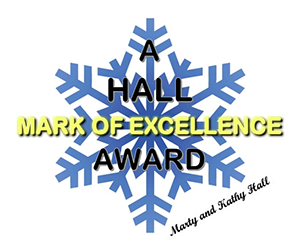 This World Cup coverage is made possible through the generous support of Marty and Kathy Hall and A Hall Mark of Excellence Award. To learn more about A Hall Mark of Excellence Award, or to learn how you can support FasterSkier’s coverage, please contact info@fasterskier.com.
This World Cup coverage is made possible through the generous support of Marty and Kathy Hall and A Hall Mark of Excellence Award. To learn more about A Hall Mark of Excellence Award, or to learn how you can support FasterSkier’s coverage, please contact info@fasterskier.com.
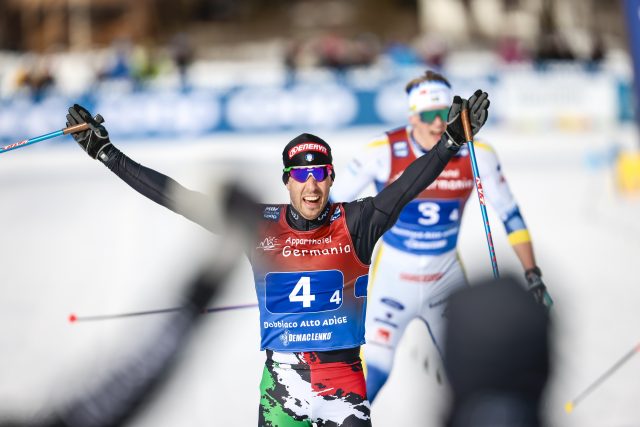
The FIS World Cup calendar refers to this village as “Toblach,” but there’s more than one name for this wonderful, mountainous place. Located in the Sud Tirol of Northern Italy—a region suspended between Italy and Austria—this is a place where more than one language is spoken, more than one cuisine is served, and each town is known by more than one name (one German, one Italian). FIS may call it Toblach (the German-language version), but Italians, themselves, would likely call it “Dobbiaco.”
Today, the Italians earned the right to call it whatever they want, as the Italy I relay team of Dietmar Noeckler, Francesco de Fabiani, Simone Dapra, and Federico Pellegrino was victorious in the World Cup 4 x 7.5 k Relay (the first World Cup relay victory for Italy since 2006). They were followed across the finish line by second place Sweden (Eric Rosjoe, Calle Halfvarsson, Johan Haeggstroem, Edvin Anger) and third place Norway I (Sjur Roethe, Didrik Toenseth, Simen Hegstad Krueger, Harald Oestberg Amundsen).
Nordiq Canada did not enter a men’s relay team in Toblach, but the team from the United states (Hunter Wonders, Scott Patterson, Finn O’Connell, and Kevin Bolger) benefitted from a late race resurgence that saw them press forward to finish ninth.
Men’s 4 x 7.5 k Relay
Norwegian skiers may appear to have all the advantages, but each Norwegian competitor does suffer one distinct disadvantage . . . it’s the need to constantly beat the other Norwegian skiers. With the possible exception of current World Cup leaders Johan Hoesflot Klaebo and Paal Golberg, Norwegian skiers always seem to be auditioning for World Championship spots. With two Norwegian teams entered in today’s relay, that seemed like a situation likely to keep the pace high. That sort of aggressive pace-making allows a team like Italy to remain patient, to play defense, to mark the moves of more aggressive skiers, and to put their nation’s premier sprinter into the anchor leg so that he can unleash a sprint. The challenge for Italy, then, would be figuring out how to stay close while two teams of ambitious Norwegians slugged away at each other.
First Leg
Erik Valnes (Norway II) pushed the pace in the first classic leg, gapping the main field and establishing an 11 second lead at the exchange. Wonders had fallen off the pace halfway through the first leg, and was already 20 seconds behind by the 6.4 k checkpoint. By the time Wonders tagged Patterson to begin the second leg, USA was 33 seconds back in 11th place.
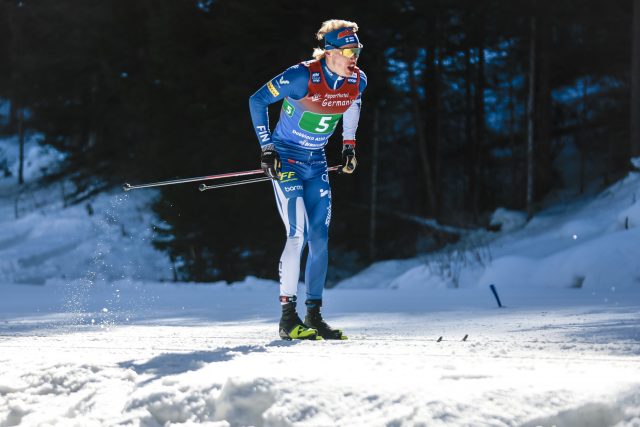
Second Leg
Inheriting Valnes’ lead from the first leg, Hans Christer Holund (NORWAY I) continued increasing the gap ahead of the chase group. Most skiers in the second leg would’ve looked to classic specialist, Iivo Niskanen (FIN) to instigate a chase of the leader, though Niskanen seemed content to linger at the rear of the chase group. The first half of Niskanen’s leg seemed to be more of a training ski for him, but at the end of his first lap he unleashed an attack, setting off in pursuit of Holund. Calle Halfvarsson (SWE) followed Niskanen, and the field began to string out. In only a few minutes, Niskanen was able to close the gap to Holund (leading De Fabiani, and Halfvarsson). Midway through the second lap, all the leaders had come back together.
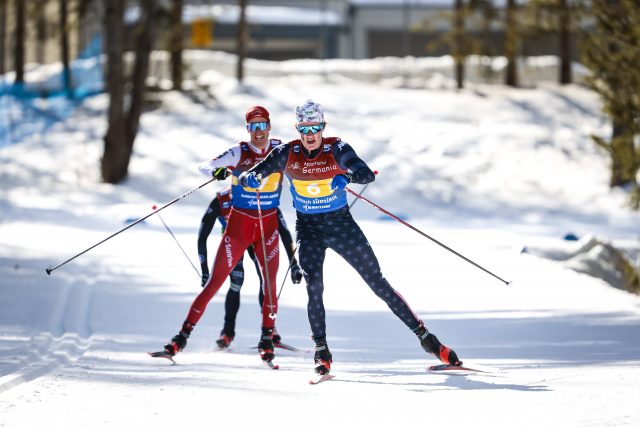
Third Leg
Norway returned to the front at the beginning of the third leg, led by Krueger who clogged the front and slowed the pace on narrower skate tracks that included the classic tracks of the earlier legs. World Cup skiers are certainly capable of skating right through the classic tracks, but at this point in the race all seemed content to follow a more moderate pace. Norway certainly had skiers fast enough to push the pace, but somehow a decision was made to slow things down. As it turned out, this was exactly the break in the action that the Italian team needed.
Ultimately, Krueger did markedly increase the pace up the main hill, surprising his Norway II rival, Iver Tildheim Andersson, who struggled to hang on to the rear of the lead group. Despite being a World Cup winner this season, Andersson is most likely being left out of Norway’s World Championship team. That may have inspired him to drive back into contention on the consequential downhill . . . he rocketed into second as the third leg neared its end. Italy fell off the pace, and the lead group had shrunk to six as the racers entered the stadium for the final exchange.
Anchor Leg
Norway I handed off a lead of a few seconds to the final skier, Amundsen. Norway II blew the exchange and exited the stadium at the back of the lead group. The cagey veteran, Pellegrino, was able to overcome the gap with which Italy had entered the final exchange; he maneuvered back into contention and settled into the lead group. With two 3.75 k laps remaining, Amundsen found himself in a not-unexpected predicament: a distance specialist surrounded by rival anchor leg skiers who are primarily sprinters: Edvin Anger (SWE), John Maki (FIN), Richard Jouve (FRA), and the always-dangerous Pellegrino.
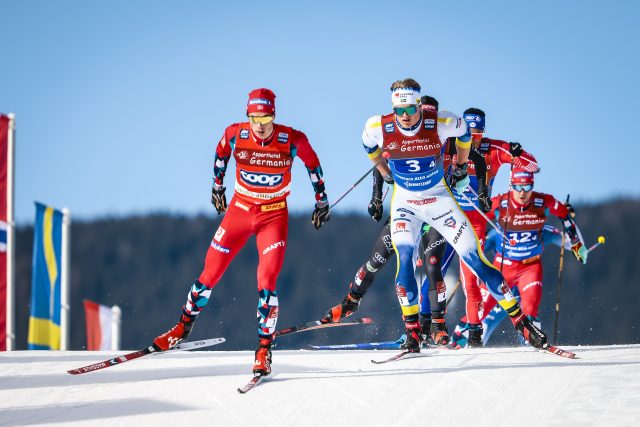
Amundsen established a significant gap at the beginning of the anchor leg, making it appear as though the finish could be a foregone conclusion. Spectators have seen Norway pull away so many times in the final leg of a relay, why would this day be any different? But Jouve recognized the chance to ski France onto the podium if he, himself, were the only sprinter brave enough to drive forward. Jouve set off in lone pursuit of Amundsen, leaving other strong sprinters in the chase (Maki, Pellegrino, Anger, Skar) to consider their options, to evaluate their strength, and to decide whether or not sprinting for third would be satisfactory.
Jouve made contact with Norway (Amundsen), putting himself in position to contend in a final sprint (in which he would certainly be the favorite). Responding to Jouve’s presence, Amundsen seemed to sit up a bit, allowing the lead group to come back together with one lap remaining. Amundsen may have hoped to wear out the sprinters, but he had to know that one attack would not be enough. There would need to be more action in the final lap. The only real distance skier among the sprinters, Amundsen would need to go back to the lead: he’d have no choice. Amundsen went to work, gradually ratcheting up the pace, hoping to take the final sting out of the sprinters. Knowing how the final kilometers would certainly play out, Pellegrino marked Amundsen as Jouve came apart (his earlier efforts proving to have been too taxing to keep up with Amundsen’s late-race pace). Likewise, Maki and Florian Notz (GER) also lost contact with the leaders, and the final group had shrunk to four: Amundsen, Skar, Anger, and Pellegrino.
Who knows why he would have chosen to do so, but Anger—a sprinter whose best strategy would’ve been to let others lead, and sprint at the last moment—led out the sprint with nearly a kilometer left to race. Way too early, way too far . . . and Pellegrino was only too happy to let Anger do the work. The finish of the relay is the same as the sprint course, and Pellegrino knew perfectly well how to construct his finishing sprint. Accelerating up the final hill, Pellegrino surged around Anger, squeezing the Swede into a position that pinched the line available to both Norwegian teams, delaying them just long enough for Pellegrino to get away. It was; of course it only succeeded because of Pellegrino’s unique prowess as both a sprinter and a distance skier. It’s supremely difficult to be in that position, to have that energy left, to know how to do what Pellegrino did, and then to pull it off in front of his Italian fans.
The relay win in Dobbiaco represented the first Italian victory in a World Cup relay since 2006. It’s unlikely that Italy will be able to pull off a similar win at the World Championships in three weeks when Norway puts all its strongest skiers onto one team, but for the day in Toblach, the sun definitely shined on the Italians.
Pellegrino revealed how much thinking and calculating goes into racing at this level. He commented that the team needed to ski intelligently and defensively to remain in contention: “And they did,” he beamed. He commented that he hoped his skis would be fast enough: “And they were,” he grinned. “I only needed to stay with the strongest team in the world, and then be the strongest.” He was . . .
“Victory for us, victory for the whole Italian team,” De Fabiani was heard to say. Let the Italian celebrations commence . . .
Men’s 4 x 7.5 k Relay RESULTS
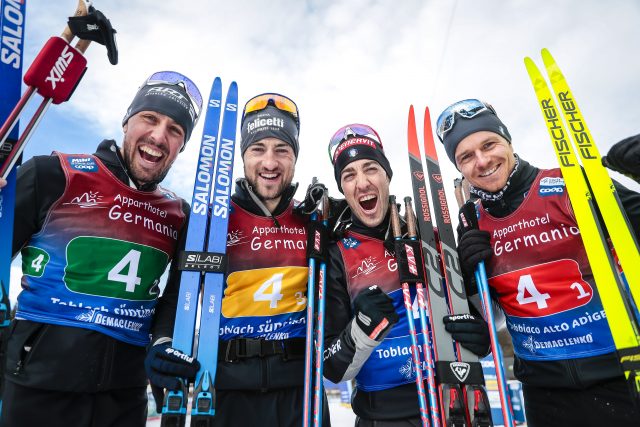
John Teaford
John Teaford—the Managing Editor of FasterSkier — has been the coach of Olympians, World Champions, and World Record Holders in six sports: Nordic skiing, speedskating, road cycling, track cycling, mountain biking, triathlon. In his long career as a writer/filmmaker, he spent many seasons as Director of Warren Miller’s annual feature film, and Producer of adventure documentary films for Discovery, ESPN, Disney, National Geographic, and NBC Sports.



